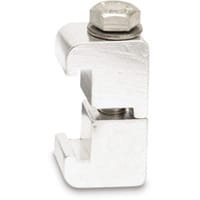ISO-K HV Double Clamps (Cold Steel, Zinc Plated): Heavy-Duty Fastening for ISO-K High-Vacuum Flange Systems
ISO-K HV Double Clamps (Cold Steel, Zinc Plated) are industrial-grade fastening components designed specifically for securing ISO-K style vacuum flanges in high-vacuum (HV) systems. These clamps provide a robust and repeatable method of compressing two ISO-K flanges together with a centering ring and o-ring in between, ensuring a leak-tight, high-integrity vacuum seal suitable for pressures down to 10⁻⁸ Torr.
Unlike single clamps, which may be used for both ISO-K and ISO-F connections, ISO-K HV Double Clamps are exclusively engineered for use with ISO-K flanges—the quick-clamp version of large ISO vacuum connections. These flanges feature claw-style ears that accept double clamps positioned 180° apart, enabling fast assembly, even torque distribution, and easy disassembly without specialized tools.
Constructed from cold-rolled steel and finished with zinc plating, these double clamps offer excellent mechanical strength and moderate corrosion resistance. The cold steel body delivers high clamping force, while the zinc coating helps prevent rust during storage or operation in non-corrosive environments. These clamps are a practical solution for industrial vacuum systems, high-vacuum chambers, process vessels, and R&D equipment where both strength and economy are required.
Key Features of ISO-K HV Double Clamps (Cold Steel, Zinc Plated):
Designed for ISO-K Flanges Only
Optimized geometry for clamping ISO-K flanges with matching centering rings and elastomeric o-rings.Material: Cold Steel with Zinc Plating
Provides strength, durability, and basic surface protection against oxidation.High-Vacuum Compatibility
Supports system integrity for vacuum levels down to 10⁻⁸ Torr when used with properly sealed ISO flange connections.Quick Assembly & Reusability
Clamps can be applied or removed quickly by hand or using a standard wrench, making them ideal for modular or reconfigurable vacuum setups.
TFM supplies ISO-K HV Double Clamps (Cold Steel, Zinc Plated) in standard ISO sizes—ISO63, ISO100, ISO160, ISO200, ISO250, ISO320, ISO400, and above. All clamps are precision-machined and quality-inspected to ensure consistent performance, even under repeated use. For users requiring higher corrosion resistance, TFM also offers alternative clamp options in aluminum or stainless steel, suitable for cleanroom or reactive gas applications.
In summary, ISO-K HV Double Clamps (Cold Steel, Zinc Plated) provide a reliable, high-strength fastening method for securing ISO-K flange connections in HV systems. Their heavy-duty construction, ISO standard compliance, and ease of use make them a dependable choice for laboratories, vacuum equipment manufacturers, and industrial system builders alike.
Ordering Table
| Flange OD | Reference | Per Package | Material | Part Number |
| ISO63-ISO250 | Double Clamps | 1 | Cold Steel, Zinc Plated | QF-LDC-CS1 |
| ISO320-ISO500 | Double Clamps | 1 | Cold Steel, Zinc Plated | QF-LDC-CS2 |
| ISO630 | Double Clamps | 1 | Cold Steel, Zinc Plated | QF-LDC-CS3 |





Reviews
There are no reviews yet.